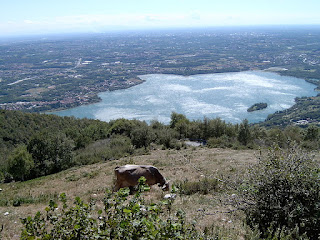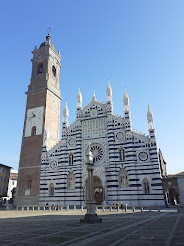Noemi - singer-songwriter
Debut album topped Italian charts
The singer-songwriter Noemi - real name Veronica Scopelliti - was born in Rome on this day in 1982. Noemi’s first album, Sulla Mia Pelle, released in 2009, sold more than 140,000 copies, topping the Italian album charts. It followed her appearance in the second series of the Italian version of The X-Factor, the television talent show that was launched in the United Kingdom in 2004. Although she did not win the competition, Noemi proved to be the most popular singer, finishing fifth overall. Soon afterwards, she landed her first recording contract, with Sony Music, and released a single, Briciole, which reached number two in the Italian singles chart. Heavily influenced by soul music, Noemi established immediately the style that has seen her nicknamed the ‘lioness of Italian pop’. The elder of two daughters of Armando and Stefania Scopelliti, Noemi - Veronica as she was then - had early experience of appearing in the spotlight - at 19 months she was chosen to model nappies in a TV commercial for Pampers. She inherited her love for music from her father, who played guitar in a group, and began learning the piano at seven and the guitar at 11. Read more…
____________________________________
Pierre Savorgnan de Brazza - explorer
Italian whose name is commemorated in an African capital
The explorer Pierre Savorgnan de Brazza, from whom Brazzaville, capital of the Republic of Congo took its name, was born on this day in 1852 in Castel Gandolfo, a town 25km (16 miles) southeast of Rome. His birth name was Pietro Paolo Savorgnan di Brazzà but he became a French citizen in 1874 after obtaining sponsorship from the French government to help fund his African expeditions, and adopted a French version of his name. Although it was because of de Brazza that much of Congo became a French colony, the transference of sovereignty took place without bloodshed and de Brazza was well liked for his friendly nature and commitment to peace. Its capital, founded in 1880, was named Brazzaville in his honour and the name was retained even after the Republic of Congo became fully independent in 1960. De Brazza was born into a noble family, the seventh of 13 children. His father, Ascanio Savorgnan di Brazzà, was a sculptor and painter who had studied under Antonio Canova; his mother, Giacinta Simonetti, hailed from a Roman family with Venetian roots. The family also owned houses in what is now Friuli Venezia Giulia at Brazzacco and Soleschiano, near Manzano, in the province of Udine. Read more…
_____________________________________
Antonio Scotti - baritone
Neapolitan singer who played 35 seasons at the Met
The operatic baritone Antonio Scotti, who performed at the Metropolitan Opera House in New York for a remarkable 35 consecutive seasons, was born on this day in 1866 in Naples. Scotti's career coincided with those of many fine baritones and experts did not consider his voice to be among the richest. Yet what he lacked in timbre, he compensated for in musicality, acting ability and an instinctive grasp of dramatic timing. Later in his career, he excelled in roles that emerged from the verismo movement in opera in the late 19th century, of which the composer Giacomo Puccini was a leading proponent, drawing on themes from real life and creating characters more identifiable with real people. For a while, Scotti's portrayal of the chief of police Baron Scarpia in Puccini's Tosca, for example, was the yardstick against which all performances were measured, at least until Tito Gobbi's emergence in the 1930s. Indeed, in 1924 the Met chose a gala presentation of Tosca as a fitting way for Scotti to mark the 25th anniversary of his debut there. Scotti's parents in Naples were keen for him to enter the priesthood but he chose to pursue his ambitions in music. Read more…
______________________________________
Friuli earthquake
First of two disasters to rock Italy in the same year
A devastating earthquake hit the area now known as Friuli-Venezia Giulia on this day in 1348. With a seismic intensity believed to be the equivalent of 6.9 on the Richter scale, the effects of the quake were felt right across Europe. According to contemporary sources, houses and churches collapsed and there were numerous casualties. It was recorded that even as far away as Rome, buildings had been damaged. The epicentre is believed to have been north of Udine to the east of the small towns of Tolmezzo, Venzone and Gemona. The earthquake happened on 25 January early in the afternoon and its effects were immediately felt in Udine, where the castle and cathedral were both damaged. In Austria the town of Villach was later hit by a landslide caused by the earthquake. Buildings in Carniola, part of present day Slovenia, and in Vicenza, Verona and Venice were also damaged. It was recorded that the Basilica di Santa Maria Maggiore in Rome was damaged by the earthquake and an ancient tower nearby developed a permanent tilt. Aftershocks were felt in different parts of Italy for several weeks. Read more…
_______________________________________
Paolo Mascagni – physician
Scientist was first to map the human lymphatic system
The physician Paolo Mascagni, whose scientific research enabled him to create the first map of the complete human lymphatic system, was born on this day in 1755 in Pomarance, a small town in Tuscany about 40km (25 miles) inland from the western coastline. Mascagni described his findings in a book with detailed illustrations of every part of the lymphatic system he had identified, which was to prove invaluable to physicians wanting to learn more about a part of the human body vital to the regulation of good health. He also commissioned the sculptor Clemente Susini to create a full-scale model in wax of the lymphatic system, which can still be seen at the Museum of Human Anatomy at the University of Bologna. Later he created another significant tome, his Anatomia Universa, which comprises 44 enormous copperplate illustrations that set out to bring together in one book the full extent of human knowledge about the anatomy of the human body. The ‘book’ in the event was so large it was never bound, each plate measuring more than 3ft 6ins (1.07m) by 2ft 6ins (0.76m), designed in such a way that those from the same plane of dissection can be placed together and show the whole body in life size. Read more…
.jpg)

.jpg)


.jpg)

.jpg)
.jpg)
.jpg)
.jpg)
.jpg)

.jpg)


.jpeg.jpeg)


.jpg)
.jpg)